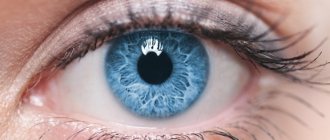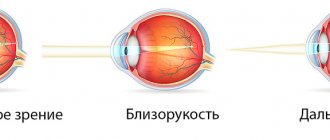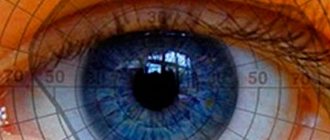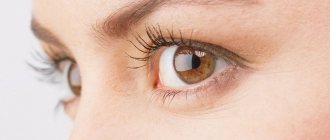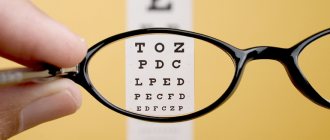Degrees of myopia may vary, however, the quality of vision can be maintained or corrected using contact optics or eye exercises. The article will discuss the characteristics of the disease, treatment methods and prevention of myopia in childhood and adulthood. We will also consider possible complications of myopia, and how to distinguish false myopia from true.
Causes of the disease and severity
With normal vision, light rays are focused in a certain area of the retina, but with this pathology this occurs beyond its boundaries. The reasons for this phenomenon may be:
- Shortened shape of the eyeball.
- The cornea or lens weakly refracts the flow of rays.
As for the degree of farsightedness, it can be:
- weak (less than +2.4 D);
- medium (from +2.4 to +4 D);
- high (more than +4 D).
What myopia and farsightedness are in simple words has already been discussed, now it’s worth learning more about its degree. Visual acuity with mild hypermetropia remains almost unchanged and is manifested only by headaches when working with close objects for a long time. Therefore, it is advisable to use special glasses for reading.
The average degree is already beginning to manifest itself: visibility of the distant surroundings is excellent, but when working close up, a feeling of discomfort soon arises.
With a high degree of pathology, it is very difficult to see both near and distant objects.
Causes
Myopia can be congenital or acquired, but in most cases it is inherited. Typically, the disease develops during school years, when there is increased strain on the eyes at close range for a long time. The situation is aggravated by insufficient lighting, reading in transport, if the child sits incorrectly while reading and writing, spends more than 2 hours a day near the TV and computer. Other reasons:
- irregular shape of the cornea;
- strabismus;
- “lazy eye” (decreased visual acuity, amblyopia);
- traumatic displacement of the lens;
- in older people it is lens sclerosis.
- astigmatism (a vision defect that causes a person to lose the ability to see clearly);
- spasm of accommodation (spasm of the eye muscles);
- keratoconus (changed shape of the cornea);
- keratoglobus (non-inflammatory disease of the cornea, which leads to its thinning and protrusion).
Myopia can also develop as a result of acute infections, hormonal imbalances, intoxication, insufficient blood supply to the eye, traumatic brain injury, or micronutrient deficiency.
Myopia
This pathology also has its own name among medical specialists - myopia. Moreover, this is a fairly common disease that affects many people around the world. In this case, a person cannot see objects located far from him. At the same time, the entire immediate environment can be clearly seen, down to the smallest details.
As for the physics of farsightedness and myopia, in the latter case it is slightly different. With myopia, the rays are focused not on the retina, but in front of it. Therefore, distant objects appear blurry.
Myopia and farsightedness. Glasses
In a person with good, normal vision, the eye, in a relaxed state, collects parallel rays at a point lying on the retina (Fig. 98, a). The situation is different for people suffering from myopia and farsightedness.
Myopia is a lack of vision in which parallel rays, after refraction in the eye, are collected not on the retina, but closer to the lens (Fig. 98, b). Images of distant objects therefore appear fuzzy and blurry on the retina. In order to get a sharp image on the retina, the object in question must be brought closer to the eye.
The distance of best vision for a myopic eye is less than 25 cm. Therefore, people with such a vision deficiency are forced to read the text, placing it close to their eyes.
Myopia can be caused by two reasons: 1) excessive optical power of the eye; 2) elongation of the eye along its optical axis. It usually develops during the school years and is usually associated with prolonged reading or writing, especially in insufficient lighting and improper placement of the light source.
Farsightedness is a lack of vision in which parallel rays, after refraction in the eye, converge at such an angle that the focus is located not on the retina, but behind it (Fig. 98, c). Images of distant objects on the retina again turn out to be fuzzy and blurry.
Since the far-sighted eye is not able to focus even parallel rays on the retina, it is even worse at collecting diverging rays coming from nearby objects. Therefore, farsighted people see poorly both far and near.
The distance of best vision for a farsighted eye is more than 25 cm. People with a similar lack of vision when reading text place it further from their eyes. This explains the name “farsightedness.”
Farsightedness can be caused either by a decrease in the optical power of the eye, or by a decrease in the length of the eye along its optical axis.
Most newborns suffer from farsightedness, but as the child grows, the eyeball enlarges somewhat, and this lack of vision disappears. In old age, people can develop so-called senile farsightedness. This is explained by the fact that the muscles that compress the lens weaken with age, and the ability of accommodation decreases. This is also facilitated by the compaction of the lens, which gradually loses its ability to shrink.
Myopia and farsightedness are corrected (compensated) by using lenses.
The first glasses appeared at the end of the 13th century. Their invention became a great benefit for people with visual impairments.
What lenses should be used in glasses to correct myopia and farsightedness?
With myopia, the image of a distant object is obtained inside the eye in front of the retina. In order for it to move away from the lens and move to the retina, glasses with diverging (concave) lenses should be used (Fig. 99, a). Such lenses have negative optical power. Therefore, if an ophthalmologist prescribes glasses to a patient, the optical power of which is, for example, –2 diopters, then this means that he is myopic.
With farsightedness, everything is different. Now the image appears behind the retina, and to move it onto it, glasses with converging (convex) lenses are used (Fig. 99, b). The optical power of such lenses is positive. Therefore, prescribing glasses whose optical power is, for example, +3 diopters means that the patient is farsighted.
??? 1. What is myopia? What are the reasons for this? What lenses are used to correct myopia? 2. What is farsightedness? What are the reasons for this? What lenses are used to correct farsightedness? 3. In the store, in the “Optics” department, glasses are available for sale: +2 diopters, –0.25 diopters, –4 diopters, +1.5 diopters. What visual impairments do these glasses correct? 4. How does the distance of best vision change in nearsighted and farsighted people?
Causes of myopia
Factors that provoke the development of myopia are the following:
- elongated eyeball;
- a strong degree of refraction of the light flux by the lens or cornea;
- weakness of the accommodative muscle (it is responsible for holding the lens);
- long close work (long stay in front of a computer or other device, reading in a weak light source or in transport).
The threat from myopia is that the organs of vision are constantly under strain, which often results in headaches. And in the dark it is more difficult to navigate on the street or drive a vehicle. But the most serious threat is retinal detachment.
Complications
The most dangerous complication of myopia is retinal detachment. Myopia can also be complicated by increased intraocular pressure, which provokes the development of glaucoma.
Complications of myopia:
- myopic cone;
- myopic staphyloma;
- peripheral chorioretinal dystrophy;
- retinal disinsertion;
- glaucoma.
The myopic cone is formed when the eyeball is pulled out, which leads to pathological changes in the optic nerve head. Myopic staphyloma (hernia) is formed when the sclera is deformed due to its weakness. This pathology is incurable, as it leads to the death of the neuroepithelium.
Progressive myopia is especially dangerous during pregnancy: there is a risk of retinal detachment during childbirth. Therefore, obstetricians-gynecologists perform a cesarean section to preserve the woman’s vision.
The consequence of peripheral chorioretinal dystrophy is retinal detachment due to the development of degenerative processes caused by the death of cells inside the eye structures. Retinal detachment is formed due to the death of neuroepithelial cells; this pathology leads to partial or complete loss of visual functions and disability.
Increased intraocular pressure (ophthalmotonus) leads to the development of a dangerous disease - glaucoma. The risk of developing glaucoma is typical for third degree myopia at any age. Glaucoma leads to a complete loss of visual functions, so you should not push yourself to irreversible processes. Timely ophthalmological care can maintain visual functions at the same level or improve the condition of the optical apparatus.
Types of myopia
As with farsightedness, myopia can also have several varieties:
- congenital;
- hereditary;
- growing.
Congenital myopia is a fairly rare phenomenon, occurring in approximately 3% of newborns. In such babies, even in the womb, the eyeball takes on an elongated shape. In other cases, the disease begins to develop in schoolchildren.
As for the hereditary form, everything is connected with a defect in the synthesis of the collagen protein (inherited), necessary for the formation of the sclera. Moreover, if one of the parents is myopic, then the risk of developing myopia in the child is 45%. If both parents are affected by the disease, then the risk is already higher – 83%.
Increasing myopia mainly affects school-age children, and their eye strain is very high. At the same time, vision deteriorates by an average of 1 diopter per year. This condition requires constant monitoring by a specialist.
Diagnostics
How to determine myopia in a child? If an adult can notice the difference between the quality of vision before the onset of the disease and after it, then a small child will not realize that he sees poorly.
Congenital
Congenital myopia can be a consequence of infectious diseases suffered by the mother during pregnancy. Parents should carefully monitor the baby in order to identify pathology in time. A child with myopia does not react to the movement of objects far from him: he sees only what is in front of his eyes. If pathology is identified during the first three years of a child’s life, it will be possible to correct vision with special exercises. Parents should take the initiative and have their baby examined by an ophthalmologist at the slightest suspicion of myopia. Congenital myopia cannot be completely cured, but vision loss can be stopped.
Hereditary
Myopia can be inherited from one of the parents, but it is extremely rare. If both parents suffer from myopia, the chance of heredity increases significantly. It cannot be cured, but it is possible to improve the condition and prevent significant vision loss.
Acquired
This type of myopia can develop for years without showing any symptoms. Acquired myopia starts from school, when the student incorrectly distributes the visual load. Parents must take the initiative into their own hands and teach their child to adhere to a daily routine and the correct alternation of work and rest. Ophthalmologists recommend not just giving the gases a rest, but also doing gymnastics for the neck and head. In the first years of school, parents should do the exercises together with the child, later he can cope with it on his own.
Classification of myopia by degree:
- weak - up to three diopters;
- medium - up to six diopters;
- strong - over six diopters.
At a doctor's appointment, the patient is offered a test using a table with letters. If deviations in the quality of vision are detected, the doctor conducts an examination of the fundus using an ophthalmoscope. This is necessary to determine the degree of pathological changes in optical structures, and also reveals the degree of their transparency.
Complex cases
We have an idea of what farsightedness or hypermetropia is, and we also became familiar with myopia (myopia). But can a person develop nearsightedness and farsightedness at the same time? Typically, there have been such difficult cases in ophthalmological practice. And the reason for this condition lies in uneven tension of the eye muscles.
But besides this, there may be other reasons:
- Uneven surface of the cornea.
- Mixed form of astigmatism or age-related farsightedness (presbyopia).
- Disruption of the central nervous system.
- Problems in the functioning of the brain.
If any vision problems are detected, you should visit an ophthalmologist and get advice about your condition and further actions.
Methods to correct the defect
After the diagnosis is finally established, the doctor determines the type of corrective therapy. From a physics point of view, glasses against myopia and farsightedness are highly effective. Actually, due to this, many people who have vision problems prefer these optical instruments. In this case, “negative” glasses are indicated for patients with myopia. To correct hypermetropia, glasses with converging lenses (plus sign) are required.
However, the treatment of myopia or farsightedness is carried out not only through the use of optical instruments. You can stabilize your vision using other methods.
Use of medications
In particular, medications designed for the eyes are no less effective. They help strengthen and relax the muscular structure of the organs of vision. They also allow you to stimulate blood circulation and metabolic processes occurring in the retina and eyeball.
Trental tablets and nicotinic acid are highly effective. But besides this, Mezaton, Taufon, Quinax, Vita-Yodurol drops, as well as vitamin complexes, are used to treat pathology.
Physiotherapy
As we now know, the main difference between farsightedness and myopia is a plus or minus before the diopter value in corrective lenses. But such a defect can be eliminated with the help of physiotherapeutic procedures, which also bring significant benefits. And this is not only a set of special exercises for the visual organs. Moreover, the effectiveness of such gymnastics depends on its regularity - it must be done daily, several times.
This may also include magnetic and laser stimulation, electropuncture and electrical stimulation. And if the disease takes on progressive forms, then the scleroplasty procedure will help.
Restorative therapy should be carried out, according to the recommendations of ophthalmologists, once every four months. People with a hereditary predisposition to vision defects are at risk. This is also worth thinking about for those who are forced to spend most of their time at the computer.
Surgery against farsightedness
The most popular types of surgical treatment for farsightedness:
- Thermokeratoplasty.
- Lens replacement.
- Lancectomy.
Thermokeratoplasty is a fairly old method of correcting the physics of farsightedness. In addition, it has some features, which is why it may not be suitable for all patients. The cornea is exposed to a heated microscopic needle. This causes damage to the upper layer, but during the regeneration period the cornea begins to tighten. Due to this, an artificial change in the refraction of the light flux occurs. However, corneal regeneration takes a very long time, and patients experience significant discomfort.
Lens replacement is done only for patients over 40 years of age, when a decrease in visual acuity is due to age-related changes. A small incision is made in the cornea, after which the worn lens is destroyed under the influence of ultrasound and a new lens is placed in its place. The operation itself takes no more than 15-20 minutes, which cannot be said about the rehabilitation period, which is quite long. Moreover, patients will have to get used to the new focus in the eyes.
Lanectomy is a new corrective technique that is recommended for patients with a high degree of hypermetropia. The procedure itself is similar to the process of replacing a lens. Instead of a lens, an intraocular lens is placed with pre-selected parameters depending on the individual characteristics of the person.
Diagnosis and treatment
The diagnosis of myopia is made by an ophthalmologist after checking visual acuity using special tables. The fundus is also examined with a special mirror. Before this procedure, the patient is usually given a medication that dilates the pupils by dropping them into the eyes. In modern clinics, ultrasound is used to examine the fundus of the eye.
If you are nearsighted, you should visit your ophthalmologist regularly, since corrective lenses and glasses need to be changed periodically. If necessary, the doctor may prescribe medication or surgical treatment.
Today, there are three ways to correct myopia : glasses, contact lenses and surgery, of which the most progressive is laser.
Glasses and contact lenses will not cure myopia, but they will help a person see better and slow down the progression of the disease. Don't expect glasses to give you eagle eyesight. Since corrective lenses should not interfere with the training of the eye muscles, glasses are selected so that a person can see (maximum) the eighth line in the table. Glasses and contact lenses are selected individually depending on visual acuity and concomitant eye diseases, and are prescribed for permanent or temporary wear.
Surgical treatment is practically the only way to completely restore vision in case of myopia, stop the progressive elongation of the eyeball and prevent the development of complications. In case of severe progressive myopia, the doctor may additionally prescribe a course of vitamins and medications that improve the nutrition of the retina.
Surgery for myopia
Since the physics of farsightedness and myopia are different, the surgical techniques used will also differ.
- Keratotomy - this operation can be indicated for patients with a slight deviation towards myopia (from -0.5 to -6 diopters). To correct complex pathology, different methods of keratotomy are used. At the same time, many experts recommend refraining from such surgical intervention if vision indicators are less than -1.5 diopters. Otherwise, in the postoperative period it is impossible to avoid the development of farsightedness.
- Keratomileusis – the indication for this procedure is myopia less than -6 diopters.
- Extreme laser correction is essentially the same keratotomy operation, but it is highlighted separately. Its main difference is the use of a laser to evaporate corneal tissue instead of a surgical knife. This procedure can correct myopia down to -6 diopters.
- Removal of the clear lens. This procedure is associated with a high risk of postoperative complications. However, it can be used to correct myopia down to -20 diopters.
All operations to correct the incorrect physics of farsightedness and myopia are distinguished by the fact that, in essence, they represent cosmetic changes.
That is, the procedures do not have strict medical contraindications. The only limitations are the patient’s capabilities and desire.
Symptoms
The first signs can be noted in childhood - parents notice that their child has difficulties in reading and writing. With myopia, objects at a distance appear blurry, indistinct, smeared, or indistinct, but the image becomes clearer if you squint. You may notice that children come closer to look at distant objects, squint, and quickly get tired due to strain on their eyes.
Patients also present the following complaints:
- overwork;
- headache;
- pain in the orbit and aching eyes;
- decreased twilight vision;
- gradual deterioration of vision.
Myopia may have no symptoms and is detected by chance during routine medical examinations.
